Rainforest protection
Tropical rainforests, the planet’s most biodiverse ecosystems, are threatened with irreversible destruction, with severe implications for global climate and biodiversity. A quintessential example is the rainforests of Borneo, home to the orangutan. The survival of these unique creatures depends on the preservation of these rainforests.
Why is it important to protect the rainforest?
You are currently viewing a placeholder content from YouTube. To access the actual content, click the button below. Please note that doing so will share data with third-party providers.
More InformationDepending on the altitude, tropical rainforests encompass lowland rainforests, mountain rainforests, and mangrove forests along the coastlines within the equatorial zone. Characterized by intense sunlight, heavy rainfall (2,000 to 4,000 litres per square metre per year), and high humidity, tropical rainforests constitute approximately 45% of all forests on earth, covering around 13% of the Earth’s land area, or 1.8 billion hectares. About one to 1.3 billion hectares of this are tropical rainforests.
Today, the most extensive contiguous regions of tropical rainforest are found in the Congo Basin, the Amazon, and Southeast Asia. These invaluable ecosystems constitute a vital part of the Earth’s “green lungs”. They are unique not only for their immense biological diversity, housing around 50% of all animal and plant species, but also for the distinctiveness of certain species. For instance, 35 of Southeast Asia’s over 200 different mammalian species live solely in Borneo.
The sound of the rainforest
The Global Impact of Tropical Rainforests
Tropical rainforests may seem remote, but they significantly influence our lives by regulating the Earth’s water cycle, the global climate, and serving as unique habitats for humans, animals, and plants. They also supply medicinal active ingredients and act as genetic repositories for research.
In the global atmospheric circulation, tropical rainforests play a critical role, balancing the warm tropical air with cold polar air. They perform a vital climate-regulating and cooling function, acting as a global air conditioning system. Additionally, tropical rainforests serve as colossal natural carbon reservoirs. They also function as natural pharmacies; half of all approved medicines originate from plants. About 1,400 tropical plants alone are believed to contain active ingredients for cancer treatment, while the tropical rainforest’s genetic pool remains largely unexplored.
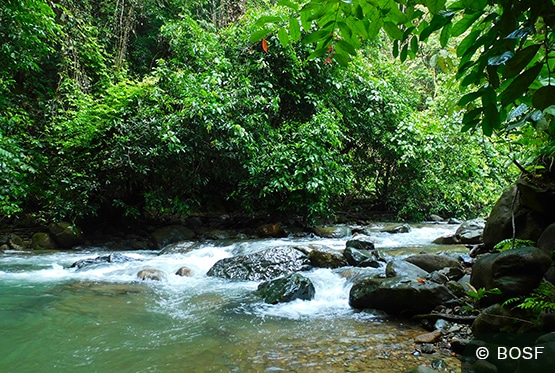
Bornean rainforest
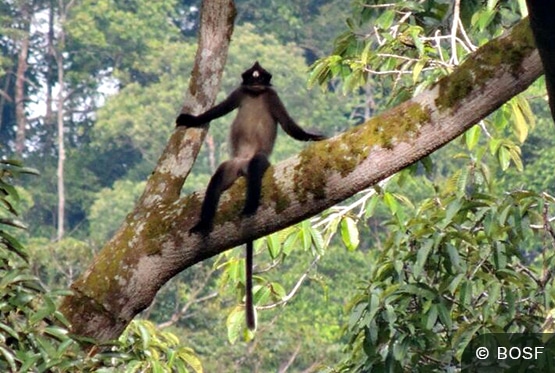
White-fronted surili is endemic to the Bornean rainforest
Threats to the Tropical Rainforests
Rapid deforestation, extensive forest fires, large-scale expansion of palm oil, paper, and soy plantations, grazing areas, along with poaching and illegal wildlife trade, seriously threaten the world’s remaining tropical forests’ flora and fauna.
Sustainable forest management, environmental protection, and ecological thinking are still exceptions rather than norms. Profit maximisation remains the priority for timber corporations, mining companies, food and palm oil industries, standing between governments and those affected — humans, animals, and plants. Consequently, large swathes of tropical rainforests are cleared annually. Satellite data analysis reveals that we lose an average of three million hectares each year. The figure reached an alarming 4.21 million hectares in 2020 — one of the highest on record — with Brazil, the Democratic Republic of Congo, and Bolivia reporting the greatest forest losses.

In Borneo, the palm oil boom of the past decades has been the driving force behind the alarming destruction of rainforests. Vast plantations, beyond imagination in size, are not only obliterating the habitats of orangutans and numerous other species but also fragmenting their habitats, leading to an escalation in human-animal conflicts. Disturbingly, if a female orangutan with offspring falls victim to such killings, the surviving baby orangutan often falls into the clutches of the illicit animal trade or becomes a pet. The Nyaru Menteng and Samboja Lestari rescue centres operated by BOS bear witness to the dire circumstances that most of the orangutans find themselves in. Frequently, our teams are summoned for rescue operations as orangutans are discovered aimlessly wandering amidst palm oil plantations. When these animals are determined to be healthy and in no immediate need of assistance, we collaborate with the conservation authority BKSDA to relocate them directly to secure rainforest areas.
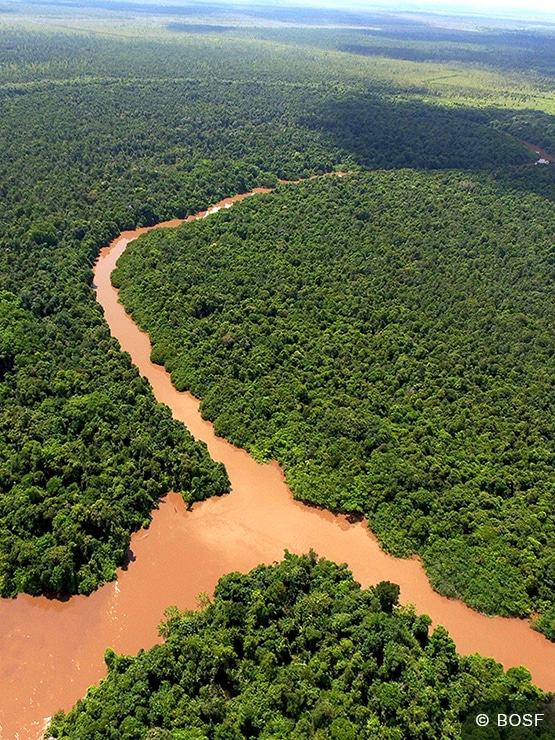
A sight from above at Salat island
How does BOS help?
BOS actively protects and restores a vast area of 460,680 hectares of rainforest with the aim of creating long-term benefits for both the local population and nature. In doing so, we actively engage the local communities in our operations.
Our journey began when we established the Samboja Lestari orangutan rescue center in East Kalimantan on a 1,853-hectare site. This area had previously suffered from deforestation and forest fires, leaving behind a nutrient-deficient grass steppe. It was at this time that we initiated the first tree planting efforts. Today, a healthy secondary forest thrives in its place. However, the devastating fires of 2015 and 2019 caused significant destruction, and the consequences will persist for a considerable time.
Samboja Lestari is also home to a diverse arboretum, housing over 750 endangered plant species listed on the “Red List.” Our ongoing efforts at Samboja Lestari focus on reforestation and forest maintenance, with particular attention to managing wildfires.
Located in Central Kalimantan, the BOS rescue center Nyaru Menteng is situated amidst a 500-hectare rainforest. Additionally, we have the pre-release Rungan River Islands (Kaja, Bangamat, Palas) spanning 178 hectares and the Salat Island Cluster covering 2,089 hectares. These areas serve as the final stages of rehabilitation for orangutans before their release into the wild. Furthermore, animals that are unable to be reintroduced into their natural habitat due to health reasons find a permanent home in these centers.
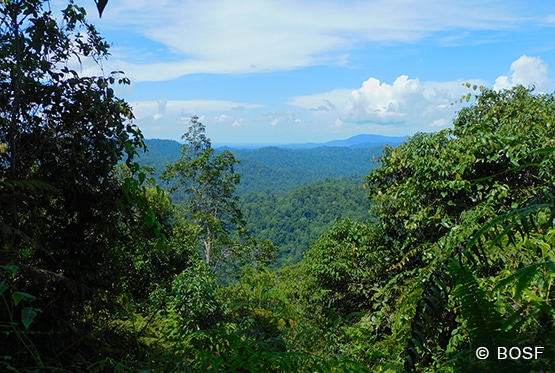
Kehje Sewen — one of BOSF release forests
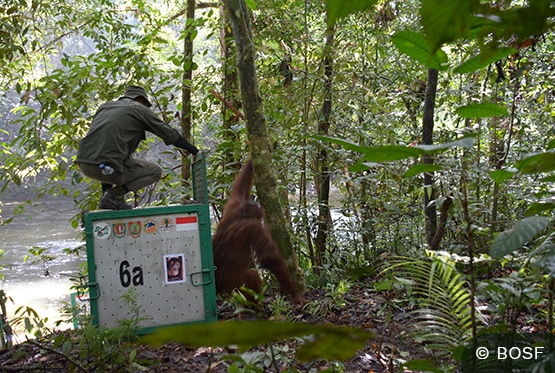
The first moment of freedom it the forest of Bukit Baka Bukit Raya
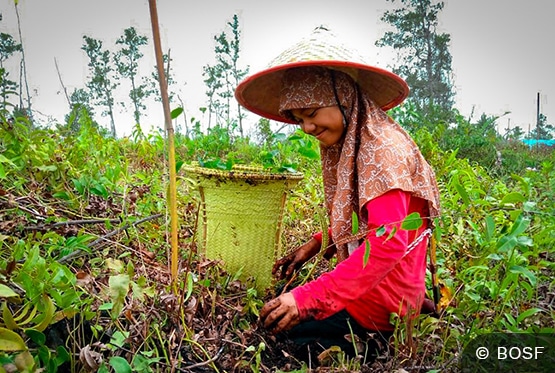
Reforestation in Mawas peatland forest, Central Kalimantan
Release and reforestation areas
To release orangutans, we look for forests that meet the criteria of intact orangutan habitats and fall under protected forest designations. In East Kalimantan, we release orangutans in the 86,600-hectare rainforest of Kehje Sewen. Nearby, there is also the 82-hectare pre-release island of Juq Kehje Swen.
In Central Kalimantan, our releases take place within a 35,000-hectare area within the 456,000-hectare Bukit Batikap protected forest. Additionally, we use approximately 22,500 hectares of rainforest within the 181,090-hectare Bukit Baka Bukit Raya National Park for releases.
Moreover, BOS protects the vast Mawas Conservation Area, covering 309,000 hectares. This expansive region was once a large-scale rice cultivation project that failed. The remaining peat swamp forest now houses one of the world’s largest populations of wild Bornean orangutans, estimated at around 2,550 individuals, along with numerous other rare animals and plants. Currently, we are undertaking a massive reforestation project on the 70,000 hectares of devastated peat swamp rainforest. This involves the closure of thousands of kilometers of drainage canals, gradual rehydration of the area, and the establishment of new rainforest. Our ultimate goal is to create a new natural habitat for orangutans within this area.
Forest for life
Save the rainforest
Saving the orangutans cannot succeed without preserving their habitat! Mawas is a thousand-year-old peat swamp rainforest housing one of the largest wild orangutan populations in Indonesia. Although significant portions of this unique rainforest were lost as part of a megaproject in the 1990s.
Now, we have a vision: To restore the forest and make it a home for even more orangutans.
Frequently asked questions
What is the connection between orangutans and rainforest conservation?
Your Subtitle Goes Here
The native habitat of orangutans is the rainforest. Here they can find food and perfect living conditions. If the rainforest is destroyed, we deprive the orangutans of their natural resources. Whoever wants to protect the orangutan must therefore also protect the rainforest — and thereby the global climate as well
Why is it important to protect the rainforest?
Your Subtitle Goes Here
Forests around the world, but especially those in Indonesia, play a crucial role in climate regulation. The great diversity of plants contributes to absorbing carbon from the atmosphere and providing us with oxygen. In addition, vegetation also helps regulate the hydrologic cycle and groundwater recharge by mitigating the surface drainage of water, ultimately maintaining groundwater levels and preventing flooding. Thus, when areas are deforested, they slowly dry out, which simultaneously increases the likelihood of dangerous flooding. This drying also creates the risk of another catastrophe: forest fires. Fires in healthy forests are a natural part of their life cycle. It can become critical when degraded forests catch fire, as these fires quickly get out of bounds. This is particularly dangerous when peat swamp forests burn. As peat is made up of decomposing organic matter, it stores an incredibly high amount of carbon. This means it can burn slowly, underground, and multiple times while releasing dangerous smog (haze) as well as large amounts of carbon. In 2015, when extreme fires burned nearly 2.6 million hectares of forest in Indonesia, it is estimated that more than 1,750,000,000 metric tons of carbon dioxide equivalent were released. That equals nearly three times the regular annual emissions for all of Indonesia. Carbon dioxide emissions on this scale continue to drive the global climate change and put us all at risk from further natural disasters. The vicious cycle continues. As we lose these forests, we also lose valuable natural resources that, if managed sustainably, would provide for the needs of people for generations to come. Local communities depend on these resources for their livelihoods — from food sources like fish and fruit to clean drinking water. Beyond the adjacent communities, these forests are important sources of timber for construction, plant material for weaving and handicrafts (rattan), medicinal agents, honey, or raw material for rubber (caoutchouc). Above all, the rainforests are home to countless different species. We currently witness the sixth mass extinction, known as the Anthropocene Species Extinction. According to estimates, the current extinction rate is 100 times the natural rate (or the expected rate). More critical approaches even assume a rate of 1,000 times. Nearly 28% of the species recorded by the IUCN (128,918) are now threatened with extinction (35,765 species). As biodiversity hotspots, tropical forests are strongholds for many of these species. Borneo is part of Sunda (geol.), one of the world’s 36 biodiversity hotspots, and is home to over 16,000 species of plants and animals. Yet across Indonesia, nearly half of the endemic — that is, native only to Indonesia — mammal species (132 out of 295) are threatened with extinction, which includes the orangutan. As we drive wild animals from their natural habitats, the likelihood that they will come into contact with humans increases. This can have fatal consequences. It is estimated that over 70% of modern infectious diseases originate in wildlife. 31% of emerging diseases are directly linked to deforestation. This is a result of the fact that forests and other natural habitats function as buffers between species. When infectious agents move from one host species to another, the likelihood of mutations increases. And so a disease that is harmless to one species can have deadly effects in another. So unless we want to find out what the next HIV, rabies, or COVID-19 might look like, we’d be wise to protect our natural world.
How can you protect the rainforests?
Your Subtitle Goes Here
Avoid palm oil that does not have a sustainability certificate. Pay close attention to the ingredient list when buying food. Palm oil or palm fat is found in many supermarket products: in ready-made meals, sweets, margarine, bread spreads, candles, cosmetics, cleaning agents and detergents. Around 85% of palm oil comes from Indonesia and Malaysia. Also approach local retailers and manufacturers about buying only products from certified palm oil cultivation. The demand still determines the supply. Most palm oil that is imported into Europe ends up in biodiesel. So not driving helps the rainforest and the orangutans, too. Use only recycled paper. Only buy colouring paper, exercise books, toilet paper and other paper products made from 100% recycled paper (recognizable by the “Blue Angel” or “ÖkopaPlus” seals). Because no rainforest has to be cleared for it. Do not buy tropical wood. When buying furniture, picture frames and other products made of wood, ask where the wood comes from. If the annual rings are missing, it may be tropical wood. Join us in creating a “Lebenswald”, a “living forest”. This way you help us to recreate a living peat swamp rainforest in Mawas and at the same time provide a new habitat for orangutans.